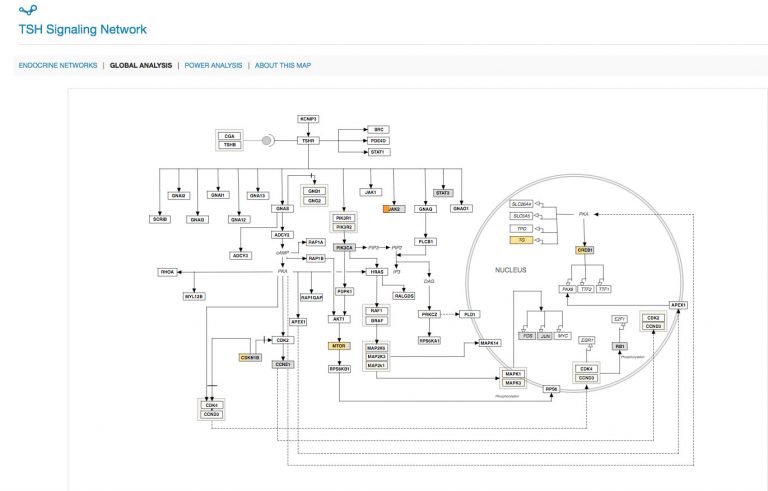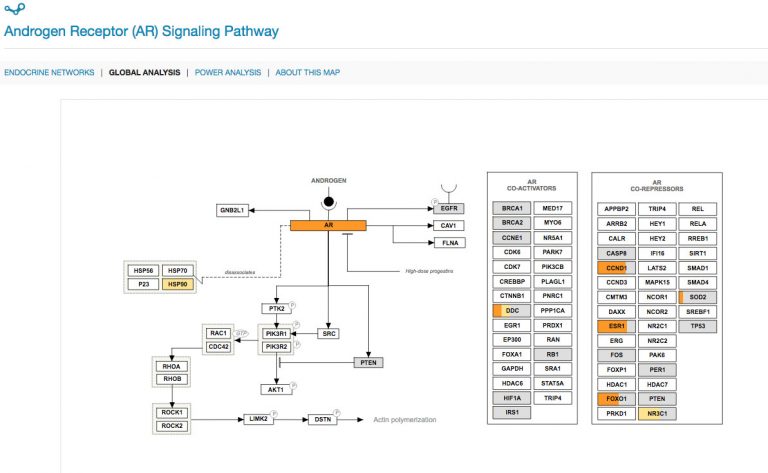We’ve added new mapping networks to Opus 23 MAPPER app. The MAPPER app allows you to visualize your client’s genomic data directly in a number of hand-curated pathway maps. In addition to allowing for quick pattern recognition, MAPPER uses combinatorics and graph theory to ascertain certain functional characteristics of genes in the network, based on their position in a web of interconnections. All gene nodes in MAPPER trigger extensive information popup windows.
TSH Signaling Network

Human thyroid stimulating hormone (TSH) is a glycoprotein secreted by the anterior part of the pituitary gland. TSH plays an important physiological role in the regulation of the hypothalamic-pituitary-thyroid axis by modulating the release of the thyroid hormones from the thyroid gland. TSH is mainly expressed in adenohypophysis , thyroid gland, leukocyte, pituitary gland, stratum basale, stratum corneum, stratum granulosum, stratum spinosum and keratinocyte. Impairment of TSH signal transduction pathway leads to thyroid disorders such as goitre, hypothyroidism and hyperthyroidism, with complex clinical manifestations. T
Endoplasmic Reticulum Stress and Unfolded Protein Response

The endoplasmic reticulum (ER) is a dynamic intracellular organelle with multiple functions essential for cellular homeostasis, development, and stress responsiveness. In response to cellular stress, a well-established signaling cascade, the unfolded protein response (UPR), is activated. This intricate mechanism is an important means of reestablishing cellular homeostasis and alleviating the inciting stress. Now, emerging evidence has demonstrated that the UPR influences cellular metabolism through diverse mechanisms, including calcium and lipid transfer, raising the prospect of involvement of these processes in the pathogenesis of disease, including neurodegeneration, cancer, diabetes mellitus and cardiovascular disease. [PMC3039444]
AR Signaling Network

Androgens, mainly testosterone and 5alpha-dihydrotestosterone (DHT) play significant role in the growth and development of the male reproductive organs. AR is found to be expressed in a number of tissues and cells including prostate, testis, seminal vescicle, epididymis, skin, skeletal muscle, cardiac muscle, liver and central nervous system. The androgen receptor is known to bind to many co-regulators at different time points and in different cell types. This DNA protein complex triggers the expression of various target genes that are associated with the male phenotype. Androgen receptors are known to induce apoptosis under certain conditions. Various regulators that regulate androgen induced apoptosis include BRCA1 and Smad3 and Akt. Mutation in AR are also known to be associated in a number of diseases including spinal and bulbar muscular atrophy (SBMA) or Kennedy’s disease and Androgen Insensitivity syndrome (AIS). Abnormal amplification of the androgen gene as well as deregulation of AR gene expression have been shown to be associated with prostate cancer.
To learn more about Opus23 training webinars, click here.
